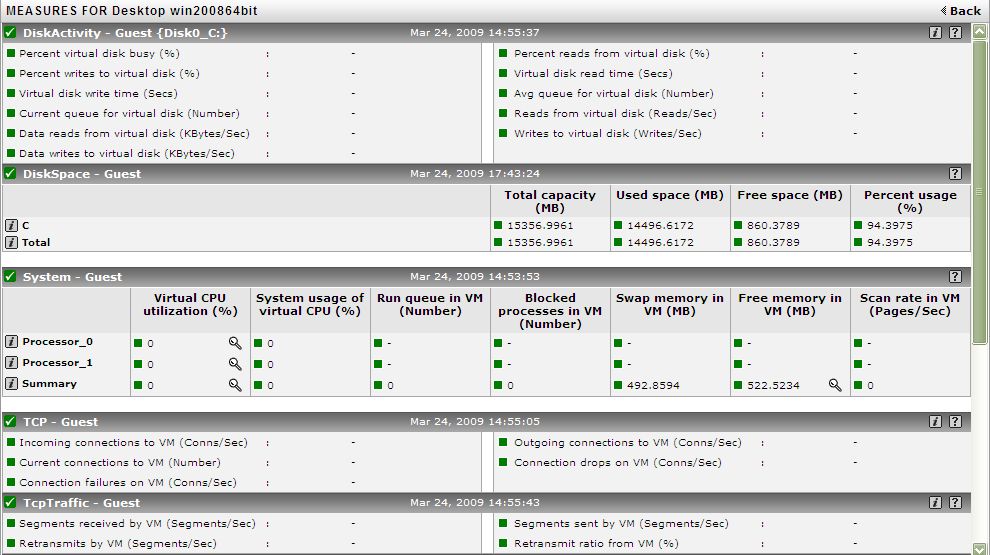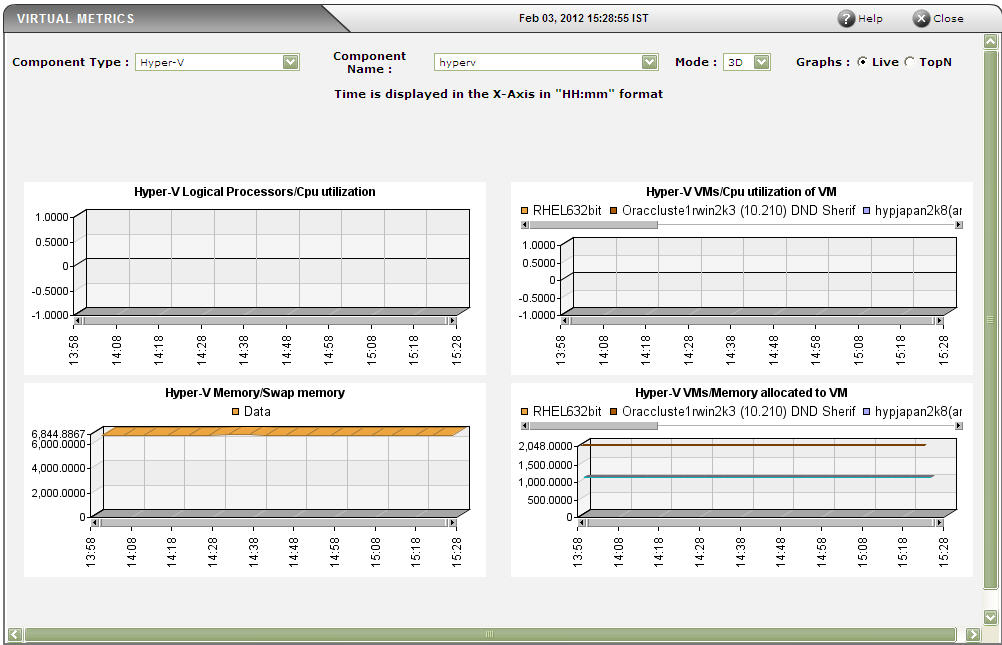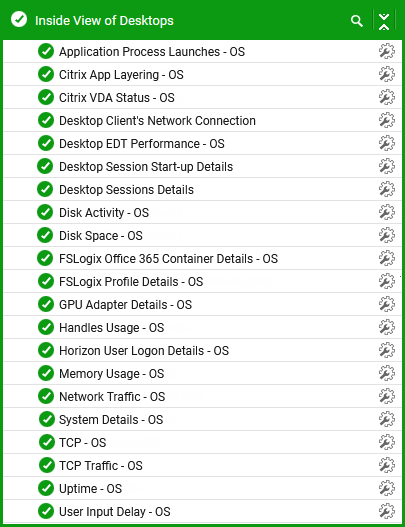The Inside View of Desktops Layer
The Outside View of VMs layer provides an “external” view of the different VM guests – the metrics reported at this layer are based on what the VMware host is seeing about the performance of the individual guests. However, an external view of the VM guest operating system and its applications may not be sufficient. For instance, suppose one of the disk partitions of the guest operating system has reached capacity. This information cannot be gleaned from host operating system. Likewise, bottlenecks such as a longer process run queue or a higher disk queue length are more visible using an internal monitor. Internal monitoring (from within the guest operating system) also provides details about the resource utilization of different application(s) or processes.
The tests mapped to the Inside View of Desktops layer provide an "internal" view of the workings of each of the guests - these tests execute on an Hyper-V host, but send probes into each of the guest operating systems to analyze how well each guest utilizes the resources that are allocated to it, and how well it handles user sessions, TCP traffic, and network loading.
By default however, clicking on the Inside View of Desktops layer, does not list the associated tests. Instead, Figure 1 appears. This figure displays the current state of all virtual desktops that have been configured on the monitored Hyper-V host.

Figure 1 : The current state of the desktops configured on the Hyper-V host that is monitored
Clicking on any of the guests in the Desktop view leads you to Figure 2 that displays all the performance metrics extracted from that guest, in real-time. You are thus enabled to cross-correlate across the various metrics, and quickly detect the root-cause of current/probable disturbances to the internal health of a guest. To view the time-of-day variations in a measure, you can view its graph by clicking on that measure in Figure 2.

Figure 2 : Measures pertaining to a chosen guest
To view real-time graphs of pre-configured measures (pertaining to the Microsoft Hyper-V host and the guests operating on it), click on the live graph link. Alternatively, you can click on the  icon that appears in the Tests panel when the Outside View of VMs layer is clicked. The graph display that appears subsequently (see Figure 3) has been organized in such a way that next to every host-pertinent measure graph, the closely related guest-specific measure graph appears. For instance, next to the graph of the 'Cpu utilization' measure of the Hyper-V Logical Processors test, you will find a graph of the 'Virtual machine cpu utilization’ measure of the Hyper-V VMs test. This way, you can easily compare and correlate how well the physical CPU resources are being utilized by both the Hyper-V host and the guests. On the basis of this analysis, you can proactively isolate potential performance issues, and also determine the root-cause of the issue - is it the Hyper-V host? or is it the virtual guest? If you access this page from the LIVE GRAPH link, then, by default, you will view live graphs pertaining to the Hyper-V VDI server. However, you can select a different virtualized component-type and a different virtualized component using the type and ComponentName lists (respectively).
icon that appears in the Tests panel when the Outside View of VMs layer is clicked. The graph display that appears subsequently (see Figure 3) has been organized in such a way that next to every host-pertinent measure graph, the closely related guest-specific measure graph appears. For instance, next to the graph of the 'Cpu utilization' measure of the Hyper-V Logical Processors test, you will find a graph of the 'Virtual machine cpu utilization’ measure of the Hyper-V VMs test. This way, you can easily compare and correlate how well the physical CPU resources are being utilized by both the Hyper-V host and the guests. On the basis of this analysis, you can proactively isolate potential performance issues, and also determine the root-cause of the issue - is it the Hyper-V host? or is it the virtual guest? If you access this page from the LIVE GRAPH link, then, by default, you will view live graphs pertaining to the Hyper-V VDI server. However, you can select a different virtualized component-type and a different virtualized component using the type and ComponentName lists (respectively).

Figure 3 : Live graph comparing physical resource usage of a Hyper-V VDI server (on the left) and resource usage levels of the individual VMs (on the right )
To return to the layer model of the Microsoft Hyper-V VDI server and view the tests mapped to the Inside View of Desktops layer, click on the component layers link in Figure 1. The tests depicted by Figure 4 then appear.

Figure 4 : The tests associated with the Inside View of Desktops layer
Alternatively, you can also configure eG to first display the tests mapped to the Inside View of Desktops layer first upon clicking it, and not the Desktop View. For this, follow the steps given below:
-
Edit the eg_ui.ini file in the <EG_INSTALL_DIR>\manager\config directory
-
Set the LAYERMODEL_LINK_TO_VIRTUAL flag in the file to false; this is set to true by default.
-
Save the eg_ui.ini file.
